An Analysis of Free Trade: Benefits, Pitfalls, and Global Impact
VerifiedAdded on 2022/08/09
|7
|1807
|441
Essay
AI Summary
This essay provides a comprehensive analysis of free trade, examining its implications in the context of globalization and the role of the World Trade Organization (WTO). The paper explores the benefits of free trade, such as increased economic growth, investment opportunities, and consumer welfare due to greater product variety and competition. It also discusses the pitfalls, including potential trade imbalances, environmental concerns, and the impact on developing economies. The essay uses the course textbook, peer-reviewed journal articles, and external resources to support its arguments, providing a balanced perspective on the complexities of free trade regimes and their impact on the global economy. The author also discusses the significance of the WTO and its contribution to both the negative and positive impacts of free trade agreements.
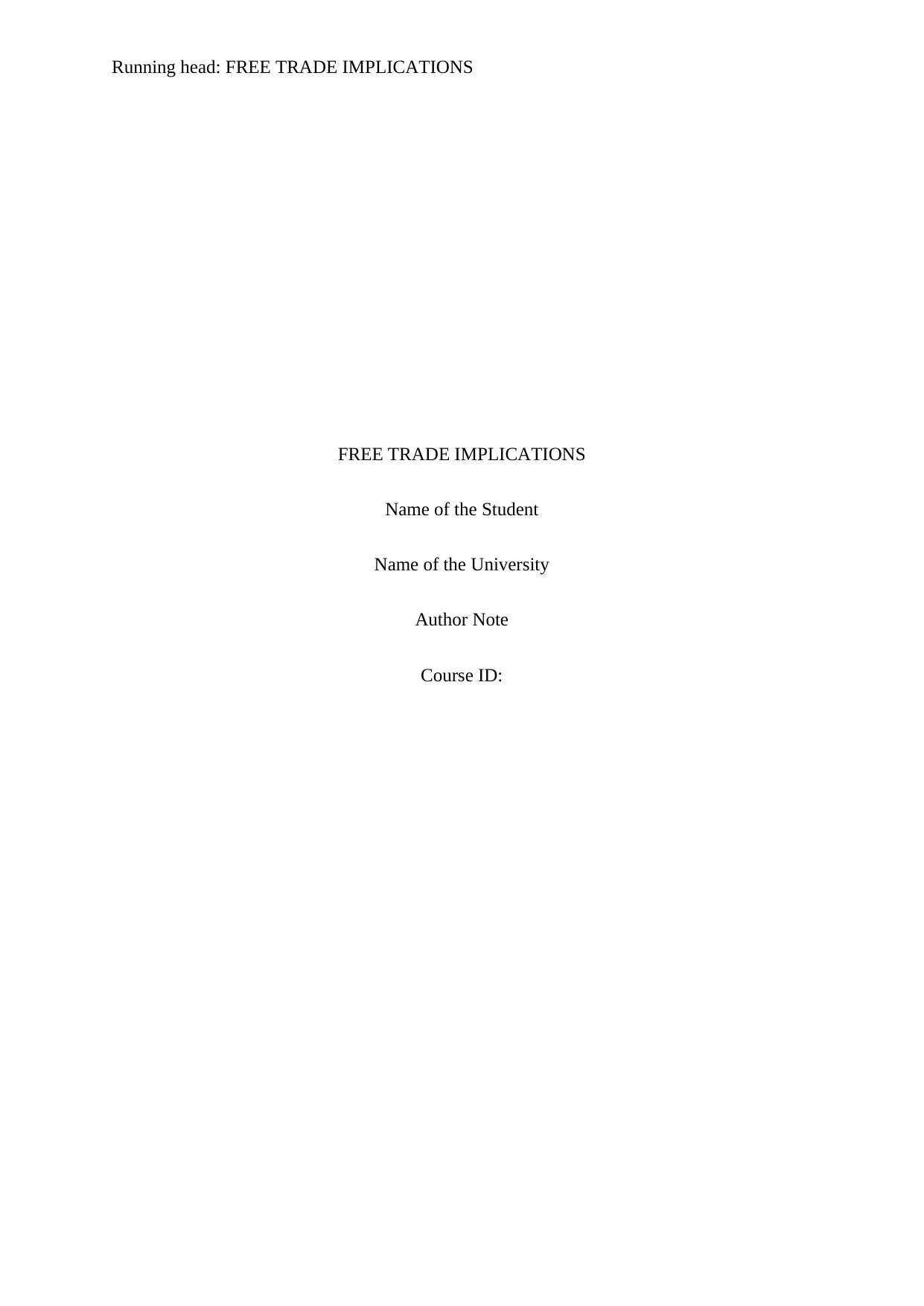
Running head: FREE TRADE IMPLICATIONS
FREE TRADE IMPLICATIONS
Name of the Student
Name of the University
Author Note
Course ID:
FREE TRADE IMPLICATIONS
Name of the Student
Name of the University
Author Note
Course ID:
Paraphrase This Document
Need a fresh take? Get an instant paraphrase of this document with our AI Paraphraser
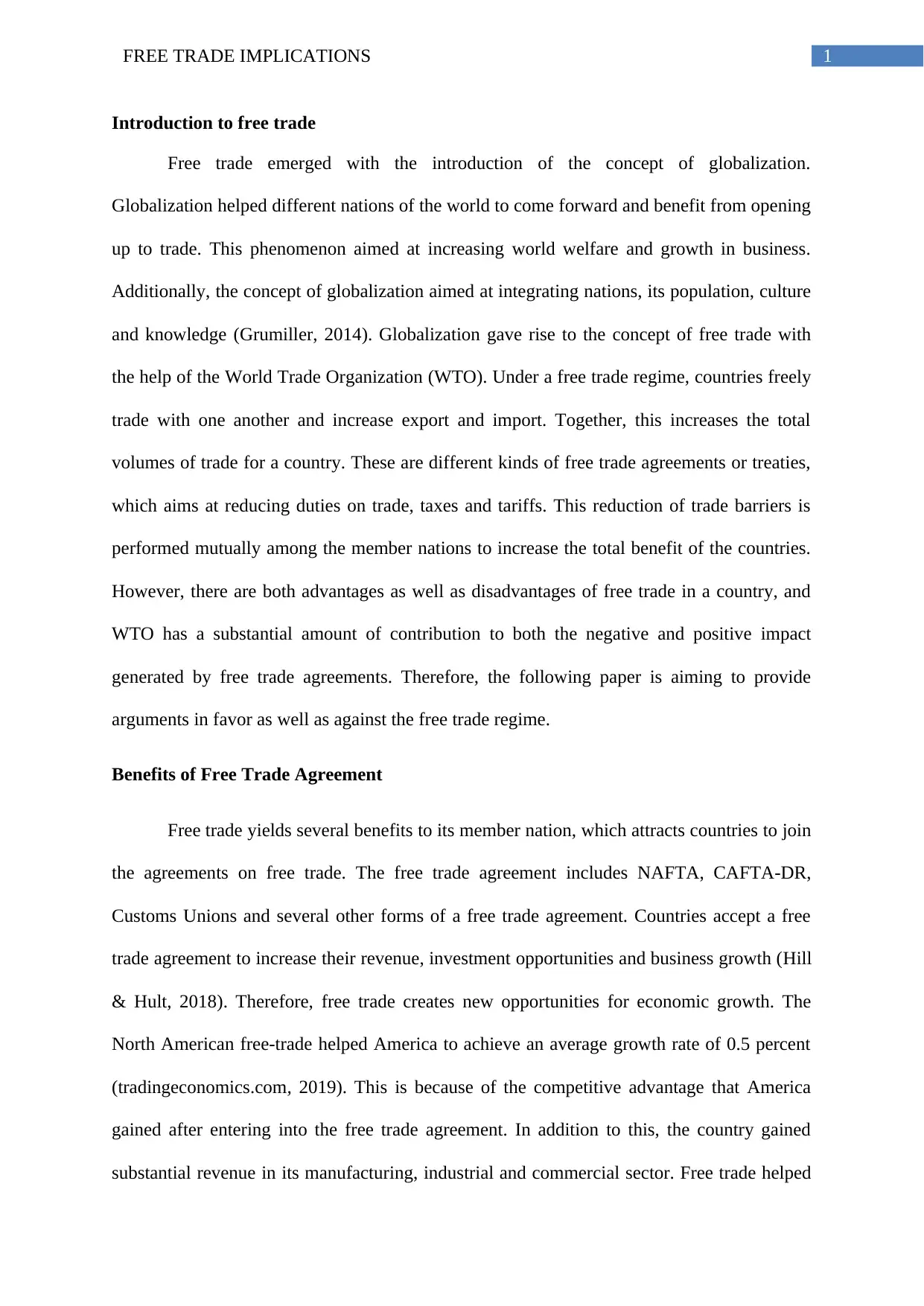
1FREE TRADE IMPLICATIONS
Introduction to free trade
Free trade emerged with the introduction of the concept of globalization.
Globalization helped different nations of the world to come forward and benefit from opening
up to trade. This phenomenon aimed at increasing world welfare and growth in business.
Additionally, the concept of globalization aimed at integrating nations, its population, culture
and knowledge (Grumiller, 2014). Globalization gave rise to the concept of free trade with
the help of the World Trade Organization (WTO). Under a free trade regime, countries freely
trade with one another and increase export and import. Together, this increases the total
volumes of trade for a country. These are different kinds of free trade agreements or treaties,
which aims at reducing duties on trade, taxes and tariffs. This reduction of trade barriers is
performed mutually among the member nations to increase the total benefit of the countries.
However, there are both advantages as well as disadvantages of free trade in a country, and
WTO has a substantial amount of contribution to both the negative and positive impact
generated by free trade agreements. Therefore, the following paper is aiming to provide
arguments in favor as well as against the free trade regime.
Benefits of Free Trade Agreement
Free trade yields several benefits to its member nation, which attracts countries to join
the agreements on free trade. The free trade agreement includes NAFTA, CAFTA-DR,
Customs Unions and several other forms of a free trade agreement. Countries accept a free
trade agreement to increase their revenue, investment opportunities and business growth (Hill
& Hult, 2018). Therefore, free trade creates new opportunities for economic growth. The
North American free-trade helped America to achieve an average growth rate of 0.5 percent
(tradingeconomics.com, 2019). This is because of the competitive advantage that America
gained after entering into the free trade agreement. In addition to this, the country gained
substantial revenue in its manufacturing, industrial and commercial sector. Free trade helped
Introduction to free trade
Free trade emerged with the introduction of the concept of globalization.
Globalization helped different nations of the world to come forward and benefit from opening
up to trade. This phenomenon aimed at increasing world welfare and growth in business.
Additionally, the concept of globalization aimed at integrating nations, its population, culture
and knowledge (Grumiller, 2014). Globalization gave rise to the concept of free trade with
the help of the World Trade Organization (WTO). Under a free trade regime, countries freely
trade with one another and increase export and import. Together, this increases the total
volumes of trade for a country. These are different kinds of free trade agreements or treaties,
which aims at reducing duties on trade, taxes and tariffs. This reduction of trade barriers is
performed mutually among the member nations to increase the total benefit of the countries.
However, there are both advantages as well as disadvantages of free trade in a country, and
WTO has a substantial amount of contribution to both the negative and positive impact
generated by free trade agreements. Therefore, the following paper is aiming to provide
arguments in favor as well as against the free trade regime.
Benefits of Free Trade Agreement
Free trade yields several benefits to its member nation, which attracts countries to join
the agreements on free trade. The free trade agreement includes NAFTA, CAFTA-DR,
Customs Unions and several other forms of a free trade agreement. Countries accept a free
trade agreement to increase their revenue, investment opportunities and business growth (Hill
& Hult, 2018). Therefore, free trade creates new opportunities for economic growth. The
North American free-trade helped America to achieve an average growth rate of 0.5 percent
(tradingeconomics.com, 2019). This is because of the competitive advantage that America
gained after entering into the free trade agreement. In addition to this, the country gained
substantial revenue in its manufacturing, industrial and commercial sector. Free trade helped
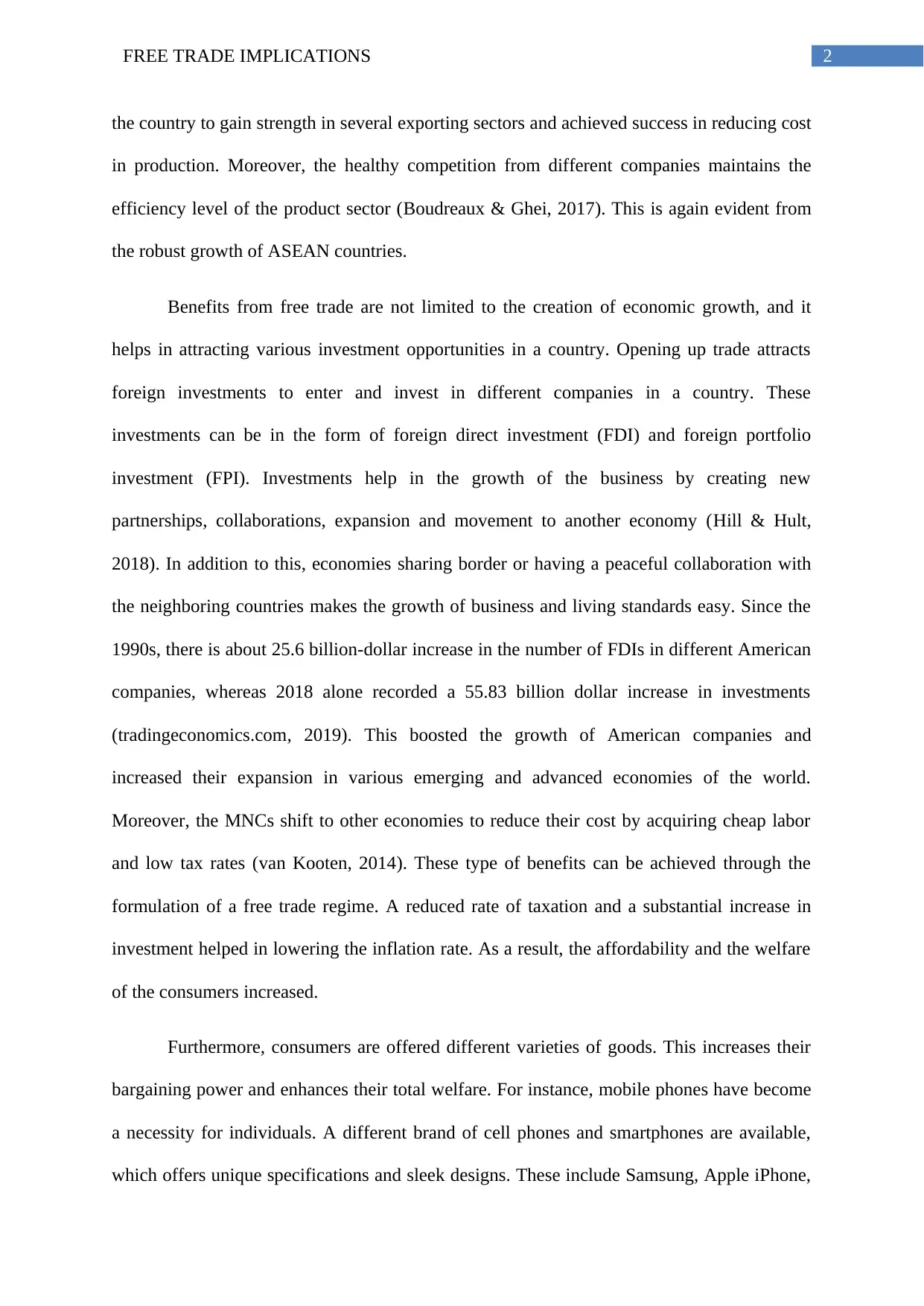
2FREE TRADE IMPLICATIONS
the country to gain strength in several exporting sectors and achieved success in reducing cost
in production. Moreover, the healthy competition from different companies maintains the
efficiency level of the product sector (Boudreaux & Ghei, 2017). This is again evident from
the robust growth of ASEAN countries.
Benefits from free trade are not limited to the creation of economic growth, and it
helps in attracting various investment opportunities in a country. Opening up trade attracts
foreign investments to enter and invest in different companies in a country. These
investments can be in the form of foreign direct investment (FDI) and foreign portfolio
investment (FPI). Investments help in the growth of the business by creating new
partnerships, collaborations, expansion and movement to another economy (Hill & Hult,
2018). In addition to this, economies sharing border or having a peaceful collaboration with
the neighboring countries makes the growth of business and living standards easy. Since the
1990s, there is about 25.6 billion-dollar increase in the number of FDIs in different American
companies, whereas 2018 alone recorded a 55.83 billion dollar increase in investments
(tradingeconomics.com, 2019). This boosted the growth of American companies and
increased their expansion in various emerging and advanced economies of the world.
Moreover, the MNCs shift to other economies to reduce their cost by acquiring cheap labor
and low tax rates (van Kooten, 2014). These type of benefits can be achieved through the
formulation of a free trade regime. A reduced rate of taxation and a substantial increase in
investment helped in lowering the inflation rate. As a result, the affordability and the welfare
of the consumers increased.
Furthermore, consumers are offered different varieties of goods. This increases their
bargaining power and enhances their total welfare. For instance, mobile phones have become
a necessity for individuals. A different brand of cell phones and smartphones are available,
which offers unique specifications and sleek designs. These include Samsung, Apple iPhone,
the country to gain strength in several exporting sectors and achieved success in reducing cost
in production. Moreover, the healthy competition from different companies maintains the
efficiency level of the product sector (Boudreaux & Ghei, 2017). This is again evident from
the robust growth of ASEAN countries.
Benefits from free trade are not limited to the creation of economic growth, and it
helps in attracting various investment opportunities in a country. Opening up trade attracts
foreign investments to enter and invest in different companies in a country. These
investments can be in the form of foreign direct investment (FDI) and foreign portfolio
investment (FPI). Investments help in the growth of the business by creating new
partnerships, collaborations, expansion and movement to another economy (Hill & Hult,
2018). In addition to this, economies sharing border or having a peaceful collaboration with
the neighboring countries makes the growth of business and living standards easy. Since the
1990s, there is about 25.6 billion-dollar increase in the number of FDIs in different American
companies, whereas 2018 alone recorded a 55.83 billion dollar increase in investments
(tradingeconomics.com, 2019). This boosted the growth of American companies and
increased their expansion in various emerging and advanced economies of the world.
Moreover, the MNCs shift to other economies to reduce their cost by acquiring cheap labor
and low tax rates (van Kooten, 2014). These type of benefits can be achieved through the
formulation of a free trade regime. A reduced rate of taxation and a substantial increase in
investment helped in lowering the inflation rate. As a result, the affordability and the welfare
of the consumers increased.
Furthermore, consumers are offered different varieties of goods. This increases their
bargaining power and enhances their total welfare. For instance, mobile phones have become
a necessity for individuals. A different brand of cell phones and smartphones are available,
which offers unique specifications and sleek designs. These include Samsung, Apple iPhone,
⊘ This is a preview!⊘
Do you want full access?
Subscribe today to unlock all pages.

Trusted by 1+ million students worldwide
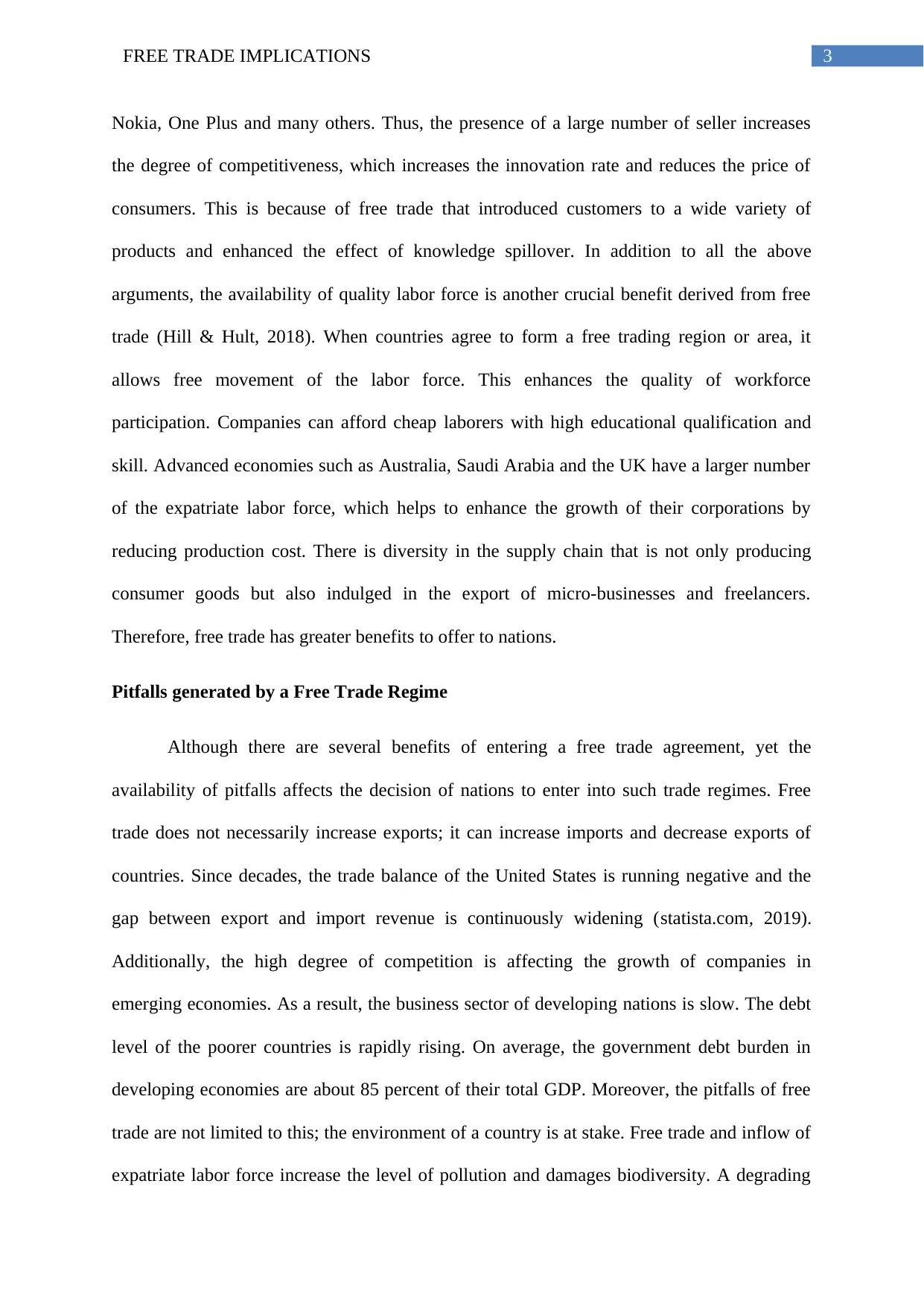
3FREE TRADE IMPLICATIONS
Nokia, One Plus and many others. Thus, the presence of a large number of seller increases
the degree of competitiveness, which increases the innovation rate and reduces the price of
consumers. This is because of free trade that introduced customers to a wide variety of
products and enhanced the effect of knowledge spillover. In addition to all the above
arguments, the availability of quality labor force is another crucial benefit derived from free
trade (Hill & Hult, 2018). When countries agree to form a free trading region or area, it
allows free movement of the labor force. This enhances the quality of workforce
participation. Companies can afford cheap laborers with high educational qualification and
skill. Advanced economies such as Australia, Saudi Arabia and the UK have a larger number
of the expatriate labor force, which helps to enhance the growth of their corporations by
reducing production cost. There is diversity in the supply chain that is not only producing
consumer goods but also indulged in the export of micro-businesses and freelancers.
Therefore, free trade has greater benefits to offer to nations.
Pitfalls generated by a Free Trade Regime
Although there are several benefits of entering a free trade agreement, yet the
availability of pitfalls affects the decision of nations to enter into such trade regimes. Free
trade does not necessarily increase exports; it can increase imports and decrease exports of
countries. Since decades, the trade balance of the United States is running negative and the
gap between export and import revenue is continuously widening (statista.com, 2019).
Additionally, the high degree of competition is affecting the growth of companies in
emerging economies. As a result, the business sector of developing nations is slow. The debt
level of the poorer countries is rapidly rising. On average, the government debt burden in
developing economies are about 85 percent of their total GDP. Moreover, the pitfalls of free
trade are not limited to this; the environment of a country is at stake. Free trade and inflow of
expatriate labor force increase the level of pollution and damages biodiversity. A degrading
Nokia, One Plus and many others. Thus, the presence of a large number of seller increases
the degree of competitiveness, which increases the innovation rate and reduces the price of
consumers. This is because of free trade that introduced customers to a wide variety of
products and enhanced the effect of knowledge spillover. In addition to all the above
arguments, the availability of quality labor force is another crucial benefit derived from free
trade (Hill & Hult, 2018). When countries agree to form a free trading region or area, it
allows free movement of the labor force. This enhances the quality of workforce
participation. Companies can afford cheap laborers with high educational qualification and
skill. Advanced economies such as Australia, Saudi Arabia and the UK have a larger number
of the expatriate labor force, which helps to enhance the growth of their corporations by
reducing production cost. There is diversity in the supply chain that is not only producing
consumer goods but also indulged in the export of micro-businesses and freelancers.
Therefore, free trade has greater benefits to offer to nations.
Pitfalls generated by a Free Trade Regime
Although there are several benefits of entering a free trade agreement, yet the
availability of pitfalls affects the decision of nations to enter into such trade regimes. Free
trade does not necessarily increase exports; it can increase imports and decrease exports of
countries. Since decades, the trade balance of the United States is running negative and the
gap between export and import revenue is continuously widening (statista.com, 2019).
Additionally, the high degree of competition is affecting the growth of companies in
emerging economies. As a result, the business sector of developing nations is slow. The debt
level of the poorer countries is rapidly rising. On average, the government debt burden in
developing economies are about 85 percent of their total GDP. Moreover, the pitfalls of free
trade are not limited to this; the environment of a country is at stake. Free trade and inflow of
expatriate labor force increase the level of pollution and damages biodiversity. A degrading
Paraphrase This Document
Need a fresh take? Get an instant paraphrase of this document with our AI Paraphraser
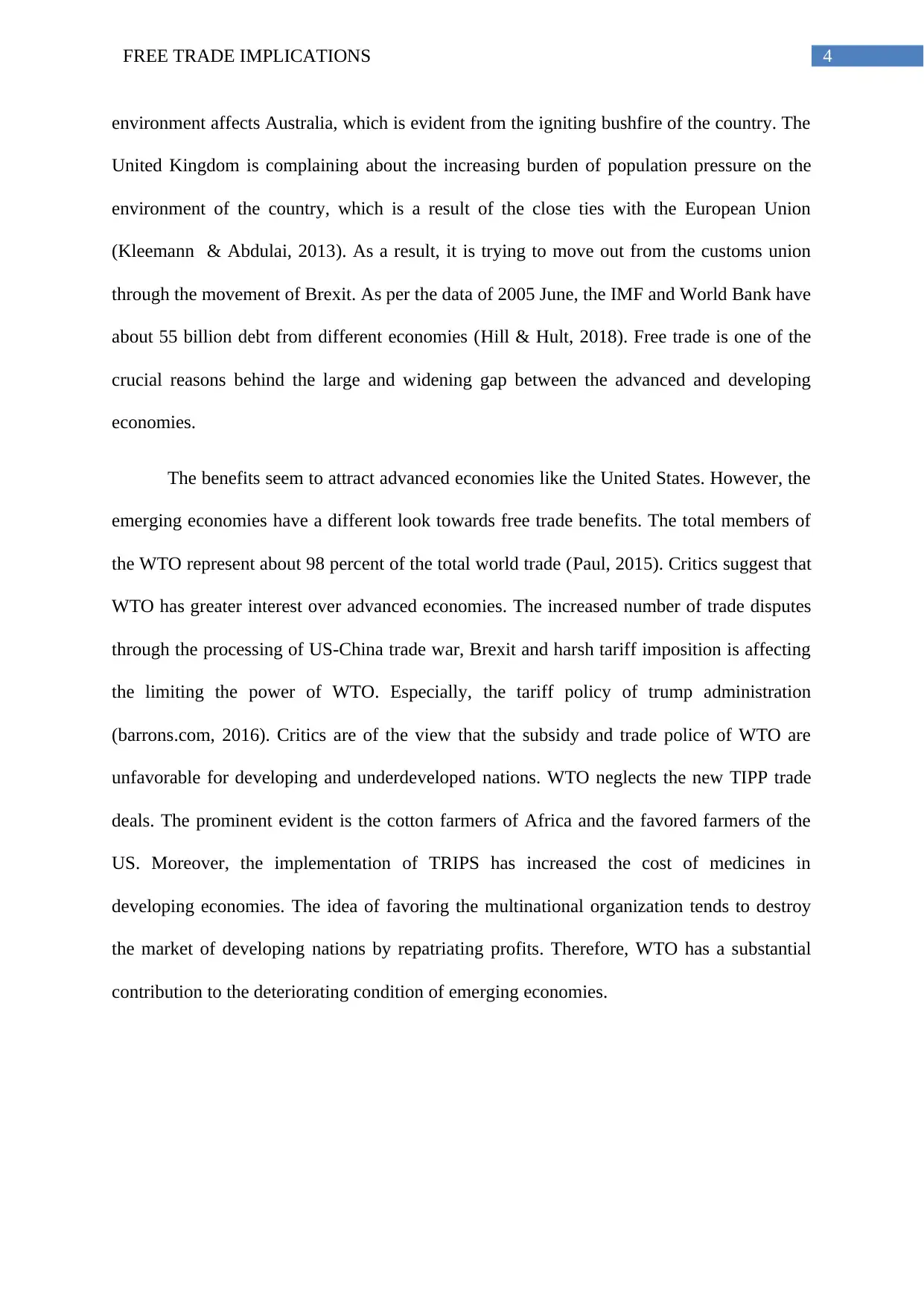
4FREE TRADE IMPLICATIONS
environment affects Australia, which is evident from the igniting bushfire of the country. The
United Kingdom is complaining about the increasing burden of population pressure on the
environment of the country, which is a result of the close ties with the European Union
(Kleemann & Abdulai, 2013). As a result, it is trying to move out from the customs union
through the movement of Brexit. As per the data of 2005 June, the IMF and World Bank have
about 55 billion debt from different economies (Hill & Hult, 2018). Free trade is one of the
crucial reasons behind the large and widening gap between the advanced and developing
economies.
The benefits seem to attract advanced economies like the United States. However, the
emerging economies have a different look towards free trade benefits. The total members of
the WTO represent about 98 percent of the total world trade (Paul, 2015). Critics suggest that
WTO has greater interest over advanced economies. The increased number of trade disputes
through the processing of US-China trade war, Brexit and harsh tariff imposition is affecting
the limiting the power of WTO. Especially, the tariff policy of trump administration
(barrons.com, 2016). Critics are of the view that the subsidy and trade police of WTO are
unfavorable for developing and underdeveloped nations. WTO neglects the new TIPP trade
deals. The prominent evident is the cotton farmers of Africa and the favored farmers of the
US. Moreover, the implementation of TRIPS has increased the cost of medicines in
developing economies. The idea of favoring the multinational organization tends to destroy
the market of developing nations by repatriating profits. Therefore, WTO has a substantial
contribution to the deteriorating condition of emerging economies.
environment affects Australia, which is evident from the igniting bushfire of the country. The
United Kingdom is complaining about the increasing burden of population pressure on the
environment of the country, which is a result of the close ties with the European Union
(Kleemann & Abdulai, 2013). As a result, it is trying to move out from the customs union
through the movement of Brexit. As per the data of 2005 June, the IMF and World Bank have
about 55 billion debt from different economies (Hill & Hult, 2018). Free trade is one of the
crucial reasons behind the large and widening gap between the advanced and developing
economies.
The benefits seem to attract advanced economies like the United States. However, the
emerging economies have a different look towards free trade benefits. The total members of
the WTO represent about 98 percent of the total world trade (Paul, 2015). Critics suggest that
WTO has greater interest over advanced economies. The increased number of trade disputes
through the processing of US-China trade war, Brexit and harsh tariff imposition is affecting
the limiting the power of WTO. Especially, the tariff policy of trump administration
(barrons.com, 2016). Critics are of the view that the subsidy and trade police of WTO are
unfavorable for developing and underdeveloped nations. WTO neglects the new TIPP trade
deals. The prominent evident is the cotton farmers of Africa and the favored farmers of the
US. Moreover, the implementation of TRIPS has increased the cost of medicines in
developing economies. The idea of favoring the multinational organization tends to destroy
the market of developing nations by repatriating profits. Therefore, WTO has a substantial
contribution to the deteriorating condition of emerging economies.
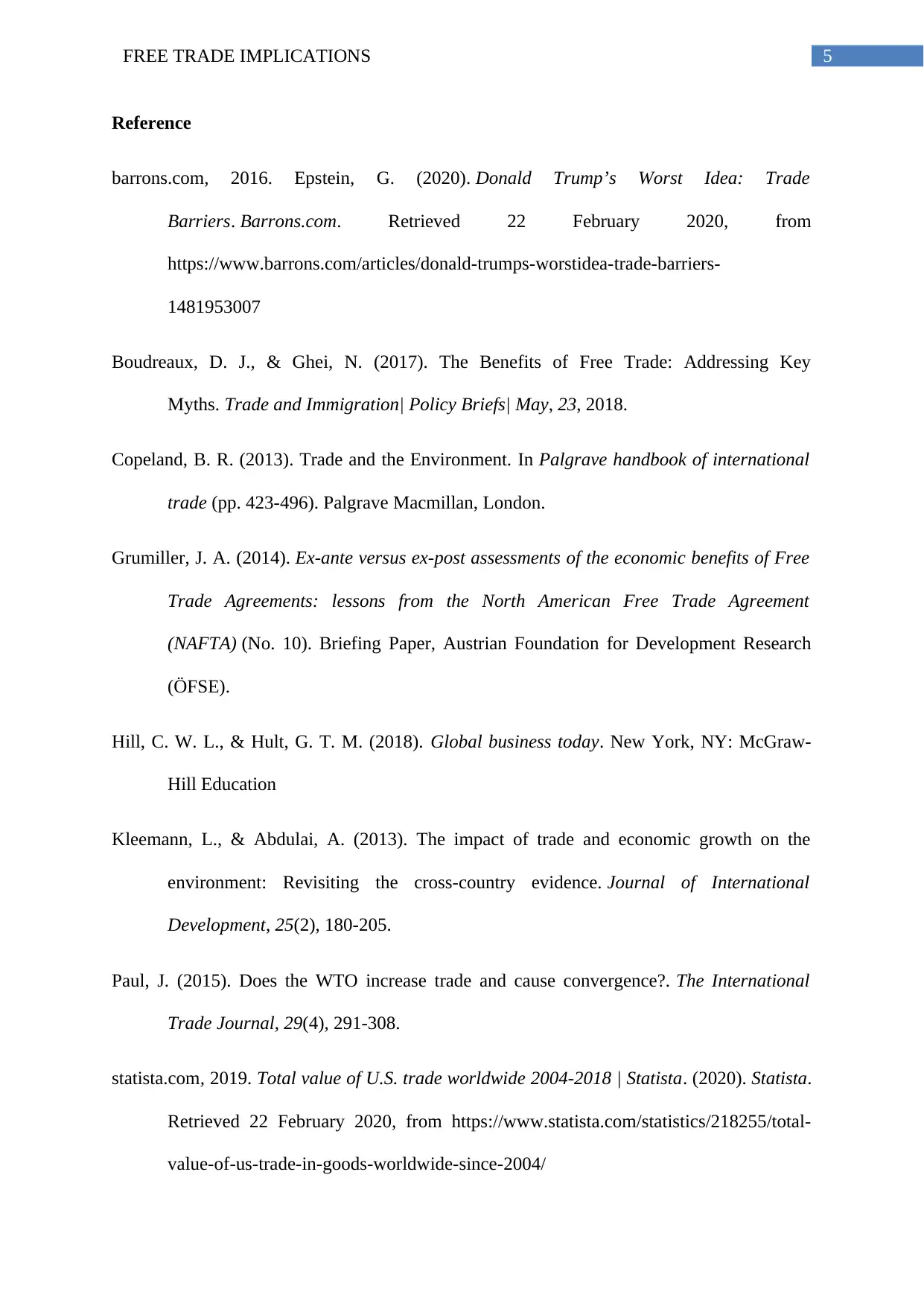
5FREE TRADE IMPLICATIONS
Reference
barrons.com, 2016. Epstein, G. (2020). Donald Trump’s Worst Idea: Trade
Barriers. Barrons.com. Retrieved 22 February 2020, from
https://www.barrons.com/articles/donald-trumps-worstidea-trade-barriers-
1481953007
Boudreaux, D. J., & Ghei, N. (2017). The Benefits of Free Trade: Addressing Key
Myths. Trade and Immigration| Policy Briefs| May, 23, 2018.
Copeland, B. R. (2013). Trade and the Environment. In Palgrave handbook of international
trade (pp. 423-496). Palgrave Macmillan, London.
Grumiller, J. A. (2014). Ex-ante versus ex-post assessments of the economic benefits of Free
Trade Agreements: lessons from the North American Free Trade Agreement
(NAFTA) (No. 10). Briefing Paper, Austrian Foundation for Development Research
(ÖFSE).
Hill, C. W. L., & Hult, G. T. M. (2018). Global business today. New York, NY: McGraw-
Hill Education
Kleemann, L., & Abdulai, A. (2013). The impact of trade and economic growth on the
environment: Revisiting the cross‐country evidence. Journal of International
Development, 25(2), 180-205.
Paul, J. (2015). Does the WTO increase trade and cause convergence?. The International
Trade Journal, 29(4), 291-308.
statista.com, 2019. Total value of U.S. trade worldwide 2004-2018 | Statista. (2020). Statista.
Retrieved 22 February 2020, from https://www.statista.com/statistics/218255/total-
value-of-us-trade-in-goods-worldwide-since-2004/
Reference
barrons.com, 2016. Epstein, G. (2020). Donald Trump’s Worst Idea: Trade
Barriers. Barrons.com. Retrieved 22 February 2020, from
https://www.barrons.com/articles/donald-trumps-worstidea-trade-barriers-
1481953007
Boudreaux, D. J., & Ghei, N. (2017). The Benefits of Free Trade: Addressing Key
Myths. Trade and Immigration| Policy Briefs| May, 23, 2018.
Copeland, B. R. (2013). Trade and the Environment. In Palgrave handbook of international
trade (pp. 423-496). Palgrave Macmillan, London.
Grumiller, J. A. (2014). Ex-ante versus ex-post assessments of the economic benefits of Free
Trade Agreements: lessons from the North American Free Trade Agreement
(NAFTA) (No. 10). Briefing Paper, Austrian Foundation for Development Research
(ÖFSE).
Hill, C. W. L., & Hult, G. T. M. (2018). Global business today. New York, NY: McGraw-
Hill Education
Kleemann, L., & Abdulai, A. (2013). The impact of trade and economic growth on the
environment: Revisiting the cross‐country evidence. Journal of International
Development, 25(2), 180-205.
Paul, J. (2015). Does the WTO increase trade and cause convergence?. The International
Trade Journal, 29(4), 291-308.
statista.com, 2019. Total value of U.S. trade worldwide 2004-2018 | Statista. (2020). Statista.
Retrieved 22 February 2020, from https://www.statista.com/statistics/218255/total-
value-of-us-trade-in-goods-worldwide-since-2004/
⊘ This is a preview!⊘
Do you want full access?
Subscribe today to unlock all pages.

Trusted by 1+ million students worldwide

6FREE TRADE IMPLICATIONS
tradingeconomics.com, 2019.United States - Economic Indicators .
(2020). Tradingeconomics.com. Retrieved 22 February 2020, from
https://tradingeconomics.com/united-states/indicators
van Kooten, G. C. (cost). Benefits and costs of impeding free trade: Revisiting British
Columbia's restrictions on log exports. Journal of forest economics, 20(4), 333-347.
tradingeconomics.com, 2019.United States - Economic Indicators .
(2020). Tradingeconomics.com. Retrieved 22 February 2020, from
https://tradingeconomics.com/united-states/indicators
van Kooten, G. C. (cost). Benefits and costs of impeding free trade: Revisiting British
Columbia's restrictions on log exports. Journal of forest economics, 20(4), 333-347.
1 out of 7
Related Documents
Your All-in-One AI-Powered Toolkit for Academic Success.
+13062052269
info@desklib.com
Available 24*7 on WhatsApp / Email
![[object Object]](/_next/static/media/star-bottom.7253800d.svg)
Unlock your academic potential
Copyright © 2020–2025 A2Z Services. All Rights Reserved. Developed and managed by ZUCOL.





